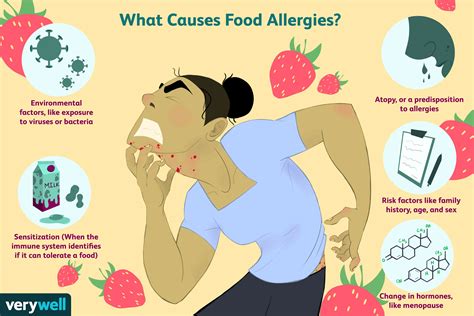
Food allergies are on the rise, leaving experts to believe modern lifestyle factors, rather than genetics alone, are primarily responsible for the surge in cases compared to previous generations.
Food allergies, once a rarity, are now a common concern, prompting scientists to investigate the potential causes behind this increasing prevalence. While genetic predispositions might play a role, growing evidence suggests that changes in our environment, diet, and hygiene practices are key drivers behind the rise in food allergies. Experts believe that our modern world may inadvertently be creating a perfect storm for the development of these conditions.
The Hygiene Hypothesis: A Cleaner World, A Weaker Immune System?
One of the leading theories attempting to explain the surge in food allergies is the “hygiene hypothesis.” This hypothesis proposes that reduced exposure to microbes and infections in early childhood can lead to an immune system that is more prone to allergic reactions. In simpler terms, our increasingly sanitized environments may prevent our immune systems from learning to distinguish between harmless substances and genuine threats.
“Our immune system is designed to be exposed to a variety of microbes in early childhood,” explains Dr. Kari Nadeau, director of the Sean N. Parker Center for Allergy & Asthma Research at Stanford University, as cited in the original Yahoo News article. “When it doesn’t get that exposure, it can become confused and start attacking things that are not harmful, like food proteins.”
The shift toward smaller families, widespread antibiotic use, and increased reliance on antibacterial products have all contributed to a less microbe-rich environment for infants and young children. This relative lack of exposure could impair the proper development of the immune system, making it more likely to react inappropriately to food proteins.
Dietary Changes: The Impact of Processed Foods
Another significant factor implicated in the rise of food allergies is the change in our diets. Modern diets are often characterized by a high intake of processed foods, refined sugars, and unhealthy fats, while lacking essential nutrients and fiber. These dietary shifts can disrupt the gut microbiome, the complex community of microorganisms living in our digestive tract.
The gut microbiome plays a crucial role in training the immune system and maintaining a healthy gut barrier. An imbalance in the gut microbiome, known as dysbiosis, can lead to increased intestinal permeability, or “leaky gut.” This allows food proteins and other substances to enter the bloodstream, triggering an immune response and potentially leading to food allergies.
The introduction of foods into an infant’s diet has also undergone significant changes. In the past, it was common practice to delay the introduction of allergenic foods like peanuts, eggs, and milk, based on the misguided belief that this would prevent allergies. However, recent research has shown that early introduction of these foods, in fact, can help to build tolerance and reduce the risk of developing allergies.
Environmental Factors: Pollution and Vitamin D Deficiency
Environmental factors, such as pollution and vitamin D deficiency, have also been linked to an increased risk of food allergies. Exposure to air pollution can damage the gut barrier and promote inflammation, making individuals more susceptible to allergic reactions. Vitamin D, obtained through sunlight exposure and certain foods, plays a crucial role in regulating the immune system. Deficiency in vitamin D has been associated with an increased risk of allergies, including food allergies.
“We know that vitamin D is important for immune function,” says Dr. Scott Sicherer, director of the Jaffe Food Allergy Institute at Mount Sinai, according to the Yahoo News article. “And studies have shown that people with lower levels of vitamin D are more likely to have allergies.”
Modern lifestyles, with increased time spent indoors and limited sun exposure, have contributed to widespread vitamin D deficiency, potentially exacerbating the risk of food allergies.
The Genetic Component: Nature vs. Nurture
While environmental factors are considered primary drivers, genetics also play a role in determining an individual’s susceptibility to food allergies. People with a family history of allergies, asthma, or eczema are more likely to develop food allergies themselves. However, genetics alone cannot explain the dramatic increase in food allergies over the past few decades.
“Genetics certainly play a role, but they don’t explain the rapid increase we’ve seen in food allergies,” Dr. Nadeau explains in the article. “Genes don’t change that quickly. It has to be something in our environment.”
The interplay between genetics and environment is complex. Individuals with a genetic predisposition to allergies may be more vulnerable to the effects of environmental triggers, such as changes in diet and hygiene practices.
Looking Ahead: Prevention and Management
Given the rising prevalence of food allergies, researchers are actively exploring strategies for prevention and management. One promising approach is early introduction of allergenic foods to infants, as recommended by current guidelines. Studies have shown that introducing peanuts, eggs, and other allergenic foods between 4 and 6 months of age can significantly reduce the risk of developing allergies.
Another area of research focuses on modulating the gut microbiome to promote immune tolerance. Probiotics, prebiotics, and fecal microbiota transplantation are being investigated as potential interventions to restore a healthy gut microbiome and prevent allergic reactions.
For individuals already diagnosed with food allergies, strict avoidance of the offending foods is the cornerstone of management. Epinephrine auto-injectors, such as EpiPens, are essential for treating severe allergic reactions, known as anaphylaxis. Additionally, oral immunotherapy, a treatment that involves gradually increasing exposure to the allergenic food under medical supervision, is gaining traction as a potential way to desensitize individuals and reduce the risk of reactions.
The Future of Food Allergy Research
The increase in food allergies poses a significant public health challenge. Ongoing research aims to further unravel the complex interplay of genetic, environmental, and lifestyle factors that contribute to the development of these conditions. By gaining a deeper understanding of the underlying mechanisms, scientists hope to develop more effective strategies for prevention, diagnosis, and treatment. Areas of focus include:
- Improved diagnostic tools: Developing more accurate and reliable tests to identify food allergies.
- Personalized prevention strategies: Tailoring prevention strategies to individual risk factors, such as genetics, family history, and environmental exposures.
- Novel therapies: Exploring new treatment options, such as biologics and gene therapy, to modulate the immune system and promote tolerance.
- Understanding the gut microbiome: Further investigating the role of the gut microbiome in the development and prevention of food allergies.
The quest to understand and combat food allergies is a multifaceted endeavor, requiring collaboration between researchers, clinicians, policymakers, and the food industry. By working together, we can create a healthier future for individuals at risk of or living with food allergies.
Expanding on Hygiene Hypothesis:
The hygiene hypothesis isn’t simply about cleanliness; it’s about the type of microbial exposure we experience. Historically, humans were exposed to a wide range of microbes from the soil, food, other animals, and each other. These exposures helped to “train” the immune system to distinguish between harmless substances and dangerous pathogens.
Modern hygiene practices, while essential for preventing infectious diseases, have inadvertently reduced the diversity of our microbial exposure. The overuse of antibiotics, in particular, can disrupt the gut microbiome and further impair immune development. Cesarean sections, as opposed to vaginal births, also alter the initial microbial exposure of newborns.
Furthermore, the delayed introduction of solid foods, especially allergenic ones, was a common practice in previous decades. This delay, based on the now-disproven belief that it would prevent allergies, actually contributed to the problem. Early exposure, on the other hand, allows the immune system to develop tolerance to these foods.
Deep Dive into Dietary Changes:
The modern diet is not only characterized by processed foods but also by a higher intake of omega-6 fatty acids and a lower intake of omega-3 fatty acids. This imbalance can promote inflammation in the body, which may contribute to the development of food allergies.
Artificial sweeteners and food additives, commonly found in processed foods, have also been implicated in disrupting the gut microbiome. These substances can alter the composition and function of the microbial community, potentially leading to increased intestinal permeability and immune dysregulation.
The rise in food allergies also coincides with an increase in the consumption of genetically modified (GM) foods. While there is no conclusive evidence that GM foods directly cause food allergies, some experts suggest that they may indirectly contribute to the problem by altering the protein content of foods or introducing novel allergens. More research is needed to fully understand the potential impact of GM foods on food allergy risk.
Exploring Environmental Factors in Depth:
Air pollution, particularly particulate matter (PM), has been shown to exacerbate allergic reactions. PM can irritate the airways and promote inflammation, making individuals more susceptible to allergic responses to food allergens. Exposure to air pollution during infancy and early childhood may have a particularly strong impact on the development of food allergies.
Besides air pollution, other environmental toxins, such as pesticides and industrial chemicals, may also play a role in the rise of food allergies. These substances can disrupt the immune system and increase the risk of allergic sensitization.
Vitamin D deficiency, as mentioned earlier, is linked to immune dysregulation. Vitamin D helps to suppress inflammatory responses and promote immune tolerance. Adequate vitamin D levels are essential for maintaining a healthy immune system and reducing the risk of allergies.
Analyzing the Genetic Component:
While genetics alone cannot explain the rapid increase in food allergies, certain genes have been identified that increase an individual’s susceptibility to these conditions. Genes involved in immune function, gut barrier integrity, and allergic inflammation have been linked to food allergy risk.
However, having these genes does not guarantee that a person will develop food allergies. Environmental factors and lifestyle choices play a critical role in determining whether or not these genes are expressed.
The concept of epigenetics is also relevant here. Epigenetics refers to changes in gene expression that are not caused by alterations in the DNA sequence itself. Environmental factors, such as diet and exposure to toxins, can alter epigenetic marks, which can then affect gene expression and influence the risk of developing food allergies.
Prevention and Management Strategies: A Closer Look:
Early introduction of allergenic foods is now widely recommended as a preventive measure. The Learning Early About Peanut Allergy (LEAP) study demonstrated that early peanut consumption significantly reduced the risk of peanut allergy in high-risk infants. Based on this study and other research, guidelines now recommend introducing peanut-containing foods to infants between 4 and 6 months of age, after they have started eating other solid foods.
Oral immunotherapy (OIT) is an emerging treatment option for food allergies. OIT involves gradually increasing the amount of allergenic food that a person can tolerate, with the goal of desensitizing them to the allergen. While OIT can be effective in reducing the risk of accidental reactions, it is not a cure for food allergies. People who undergo OIT still need to avoid the allergenic food in their daily lives.
Research into novel therapies for food allergies is ongoing. Biologics, which are drugs that target specific molecules involved in the allergic response, are being investigated as potential treatments. Gene therapy, which involves altering a person’s genes to correct a genetic defect, is also being explored as a potential cure for food allergies.
Addressing the Public Health Challenge:
The rise in food allergies poses a significant public health challenge. Food allergies can have a profound impact on the quality of life of affected individuals and their families. Accidental exposure to an allergenic food can lead to anaphylaxis, a life-threatening allergic reaction.
Food allergies also place a burden on healthcare systems. The cost of diagnosing and treating food allergies can be substantial. Furthermore, food allergies can lead to anxiety and social isolation.
Addressing the rise in food allergies requires a multifaceted approach that includes:
- Public awareness campaigns: Educating the public about food allergies and how to prevent them.
- Improved food labeling: Ensuring that food labels are clear and accurate, so that people with food allergies can easily identify allergenic ingredients.
- School and workplace policies: Implementing policies that protect students and employees with food allergies.
- Funding for research: Supporting research into the causes, prevention, and treatment of food allergies.
The role of the food industry is also crucial. Food manufacturers need to be responsible in their labeling practices and take steps to minimize the risk of cross-contamination.
The Future is in the Gut: Focusing on the Microbiome
Given the strong link between the gut microbiome and immune function, modulating the microbiome is an increasingly important area of research. Strategies being explored include:
- Probiotics: Introducing beneficial bacteria to the gut to improve its composition and function. Different strains of probiotics have different effects, and researchers are working to identify the most effective strains for preventing and treating food allergies.
- Prebiotics: Feeding the beneficial bacteria in the gut with non-digestible fibers. Prebiotics can help to promote the growth and activity of beneficial bacteria, which can then improve gut health and immune function.
- Fecal microbiota transplantation (FMT): Transferring stool from a healthy donor to a recipient with a disrupted gut microbiome. FMT has shown promise in treating a variety of conditions, including inflammatory bowel disease and recurrent Clostridium difficile infection. It is also being investigated as a potential treatment for food allergies.
- Dietary interventions: Modifying the diet to promote a healthy gut microbiome. This may involve increasing fiber intake, reducing sugar intake, and consuming fermented foods.
The food allergy epidemic is a complex problem, but with continued research and a collaborative effort, it can be addressed, leading to a healthier future for all.
The Role of Cesarean Sections and Formula Feeding:
The mode of delivery and infant feeding practices have a significant impact on the development of the infant gut microbiome and immune system. Babies born via Cesarean section miss out on the initial exposure to the mother’s vaginal microbiota, which is believed to play a critical role in seeding the infant gut.
Similarly, formula feeding, as opposed to breastfeeding, can alter the composition of the infant gut microbiome. Breast milk contains prebiotics and antibodies that promote the growth of beneficial bacteria and support the infant’s immune system. Formula, on the other hand, may not provide the same benefits.
Studies have shown that babies born via Cesarean section and/or fed formula are at a higher risk of developing allergies, including food allergies.
FAQ Section:
1. What is the hygiene hypothesis, and how does it relate to food allergies?
The hygiene hypothesis suggests that reduced exposure to microbes in early childhood, due to factors like increased cleanliness and antibiotic use, can lead to an immune system that is more prone to allergic reactions. This lack of exposure can prevent the immune system from learning to distinguish between harmless substances, such as food proteins, and genuine threats, leading to an increased risk of food allergies. As Dr. Kari Nadeau explained, “Our immune system is designed to be exposed to a variety of microbes in early childhood. When it doesn’t get that exposure, it can become confused and start attacking things that are not harmful, like food proteins.”
2. How has the modern diet contributed to the rise in food allergies?
Modern diets, often characterized by high intake of processed foods, refined sugars, and unhealthy fats, can disrupt the gut microbiome, which plays a crucial role in training the immune system and maintaining a healthy gut barrier. Imbalances in the gut microbiome can lead to increased intestinal permeability (“leaky gut”), allowing food proteins to enter the bloodstream and trigger an immune response. Furthermore, changes in the timing of introducing allergenic foods, such as delaying their introduction in infancy, have also contributed to the problem.
3. What role do environmental factors play in the development of food allergies?
Environmental factors, such as pollution and vitamin D deficiency, have been linked to an increased risk of food allergies. Exposure to air pollution can damage the gut barrier and promote inflammation, making individuals more susceptible to allergic reactions. Vitamin D is essential for regulating the immune system, and deficiency in vitamin D has been associated with an increased risk of allergies. According to Dr. Scott Sicherer, “We know that vitamin D is important for immune function. And studies have shown that people with lower levels of vitamin D are more likely to have allergies.”
4. What are some strategies for preventing food allergies?
Current guidelines recommend early introduction of allergenic foods to infants, typically between 4 and 6 months of age, after they have started eating other solid foods. This early exposure can help to build tolerance and reduce the risk of developing allergies. Other potential strategies include modulating the gut microbiome with probiotics and prebiotics, and ensuring adequate vitamin D levels through sunlight exposure and dietary sources.
5. What are the current treatment options for food allergies?
The cornerstone of food allergy management is strict avoidance of the offending foods. Epinephrine auto-injectors (e.g., EpiPens) are essential for treating severe allergic reactions (anaphylaxis). Oral immunotherapy (OIT), a treatment that involves gradually increasing exposure to the allergenic food under medical supervision, is also gaining traction as a potential way to desensitize individuals and reduce the risk of reactions. While OIT can be effective, it is not a cure, and individuals still need to avoid the allergenic food in their daily lives. Researchers are also exploring novel therapies, such as biologics and gene therapy, to modulate the immune system and promote tolerance.








